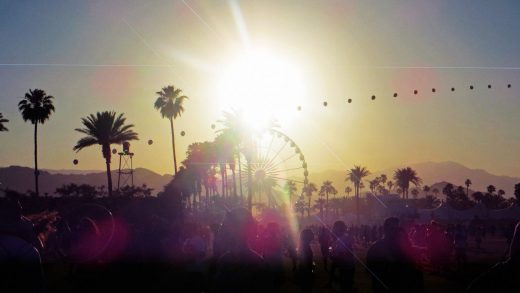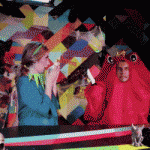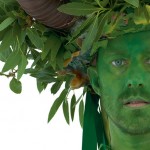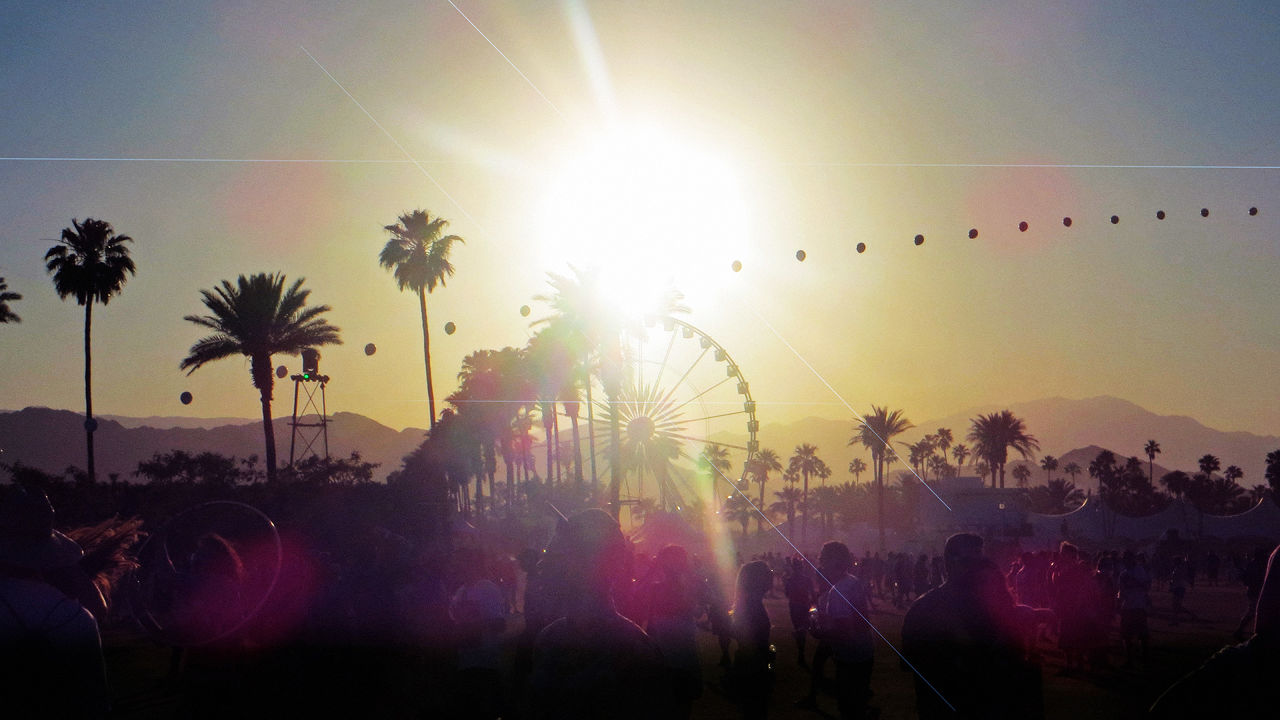“Old People Coachella” Aims To Be The Best-Tasting Rock Festival Ever
When Desert Trip was announced in May, its lineup of septuagenarian rock artists quickly earned it the nickname “Oldchella,” or “Coachella for old people.” Conversely, the mega-event featuring such luminaries as Bob Dylan, the Rolling Stones, Paul McCartney, and Roger Waters was also called the “concert of the century,” but it has an uphill climb if it wants to satisfy discerning baby-boomer foodies, who aren’t going to be impressed with the typical subpar catering fare once associated with concerts.
Fortunately, organizers have a plan to make Desert Trip more delicious: Goldenvoice, the concert promotor running the show, says more than 100 food vendors will be on hand, offering everything from vegan hamburgers to Thai street food.
“Food has become part of our shows,” explained Nic Adler, who curates the Food and Beverage Program for Goldenvoice events, which includes Coachella. “[Festivals] are such a great place to introduce food. You have that social interaction, people are having fun. I think for a long time we were just leaving it on the table and thinking that pizza and tacos [would suffice] … Now people know to come hungry.”
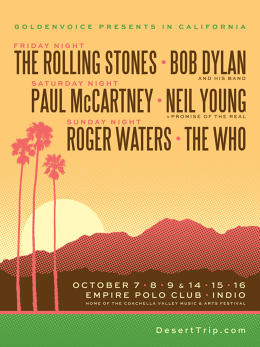
Great food at festivals isn’t necessarily new, but with Desert Trip, organizers hope to push the menu to new limits. Their chef billing reads like a who’s who of top dining establishments: Marcus Samuelsson (Red Rooster); Scott Conant (Scarpetta); Alexandra Guarnaschelli (Butter); Daniel Humm (Eleven Madison Park); Marcel Vigneron (Wolf), and more household names. There are even trendy desserts from the likes of Mallow Mallow (they serve bourbon bacon s’mores); Bluestar Donuts (they produce flavors like Blueberry Bourbon Basil); and Afters Ice Cream (inventors of the “Milky Bun,” a warm donut stuffed with ice cream).
Desert Trip, which will be held over two October weekends in Indio, California, sold out within hours in May, and over 75,000 attendees are expected. The ticket rush left some empty-handed baby boomers tweeting the Stones’ “You Can’t Always Get What You Want.” The mega-event ($199 a day / $399 for the weekend) is slated to bring together a large demographic of rock lovers, but it’s safe to presume the audience will differ in age range than more younger-skewing music festivals.
Unlike at Coachella, a more sophisticated curation of restaurants—like the iconic Venice Beach restaurant the Rose Cafe and the Southern Italian hotspot Sotto—has been tapped to reflect ticket buyers’ tastes. There will also be a craft beer barn serving microbrews and specialty cocktails as well as a curated wine program, which will include tastings, by sommelier Rajat Parr.
Parr will serve modern American wines from small, artisanal producers, a menu he described as “like a wine list for a new hip restaurant.” There will be Barbera in addition to Cabernets, but erring on the lighter variety; as Parr noted, the challenge is to serve wine that won’t put people to sleep before the night’s festivities. “I want them to feel alive when they go to the show,” he said.
The festival’s promoters put together a mix of trendy restaurants, making sure to include both higher- and lower-priced options. In fact, the site’s FAQ section pinpoints one jarring expected concern: “What if I just want a hot dog?” Don’t worry, they’ll have them. They might just be topped with rosemary-infused sriracha and topped with cilantro.
The all-inclusive “culinary experience” ($179 per day / $499 a weekend) allows attendees to spend the afternoon eating and drinking up until the evening. For those who want something a bit more distinct, there’s a $225 four-course prix fixe seated outdoor dinner produced by Outstanding in the Field, known for its picturesque events. The open-air feast generally resembles something out of a wedding reception, with a long table feted with flowers and candles and wire-hanging twinkle lights. While it might seem unorthodox, it’s all part of Goldenvoice’s vision to redefine the music festival experience—and its dining counterpart.
What else differentiates Desert Trip from its younger, more skin-baring cousin Coachella? To start, the fact that there are only two acts per night on one stage—versus dozens on several stages—demonstrates the slower, more thoughtful pace. This allows attendees to focus on the food during daylight hours and prepare for the evening’s main event. As for comfort level, Desert Trip will accommodate its more mature audience with shaded dining and air-conditioned lounges spread throughout the few hundred-acres site. Even the bathrooms are upgraded, with permanent bathrooms built on-site. “You will not see a Porta-Potty anywhere,” promised Adler.
Food Is The New Rock
Goldenvoice implemented its food program after it witnessed attendees were more than just music lovers, they were foodies as well. These hungry concertgoers care about the top restaurants, craft beer, and celebrity chefs. Organizers began more seriously tending to food and beverage activation, but in a way that would appeal to today’s connected culture.
“I talk to all the chefs and I say, let’s make beautiful food, because people are going to take pictures of it,” explained Adler. “It’s like sharing a piece of art or your favorite band: sharing a shot of an ice cream donut sandwich is the perfect way to say, ‘Hey, I’m having the time of my life.'”
It’s why “bowl culture” has taken off at festivals—because nothing takes a better picture than food in a bowl. At last year’s Coachella, Sweetfin Poké became the weekend’s bestseller and social media superstar, thanks to its photogenic properties. Food has become as viral as the coolest bands, with certain edible items, like say EggSlut’s juicy egg breakfast sandwich, clogging the event’s hashtags on Instagram.
Festival-goers, however, need time to adapt to culinary changes. In 2014, Goldenvoice launched its first food program at Coachella by inviting noted chefs to outfit the festival with deluxe sandwich stands and sushi bars—a stark difference from the pizzas and hot dogs of previous generations. The first year Goldenvoice experimented with these upscale food vendors, it wasn’t an immediate hit: Attendees were confused by kale salad at a rock festival. Whereas today, says Adler, “If we did a kale salad at Coachella, it could be the No. 1 selling item.”
In the following years, once the public knew what to expect, Goldenvoice went after restaurants many people had heard of—on Eater, for instance—but hadn’t necessarily tried yet. This year’s audience got a taste of KazuNori sushi or Night + Market’s crispy rice salad. Participants change yearly, with Goldenvoice opting for only a few returning vendors, like Sage Vegan Bistro, which sells items like quinoa corn cakes.
Zach Brooks, 40, is a festival-goer and host of the podcast Food Is The New Rock. He’s seen the progression of music festival dining, noting that today’s food options are as big a draw as the music. In a way, it’s basically become two festivals—food and music—combined in one.
“It’s been amazing how great a job [Goldenvoice organizers] have done is such a short amount of time,” he said, adding that food at Coachella 2016 “was the best food at any music festival that exists.”
Brooks witnessed how certain concepts, such as mini-restaurants in the Coachella VIP lounge, took time to resonate with fans; they’d be sparsely attended in their first year, then packed the next time around. He’s confident that the more elegant ideas intended for Desert Trip, such as the four course-meal in the field, will better land with the expected fans. “That audience is way more suited for fancy meals than the Coachella crowd.”
Vendors, meanwhile, are equally excited to reach a specific audience as well as receive a certain type of exposure. Top Chef winner Michael Voltaggio, who plans on selling his cutting-edge New American fare, like nitrogen ice cream, views it as a unique marketing opportunity.
“The fact that I got to read my name in the same article as the Rolling Stones, Bob Dylan, and Neil Young was unbelievable,” he said. “That in it of itself is enough to do it—to be part of history.”
With no band playing during the day, thousands of attendees will have time to buy their favorite foods and take it easy. As organizers noted, they’re coming as much to see The Rolling Stones as they are to enjoy a relaxing vacation. And what’s a vacation without good food?
“From a culinary perspective we wanted to deliver something that was familiar to the crowd that was coming,” he said. That, coupled with iconic rock stars, is the secret sauce for Desert Trip. “All of us as we get older, we don’t get to sit down in the grass with a glass of wine under some umbrella and just talk about life and then get up and see our favorite band of all time.”
Fast Company , Read Full Story
(53)

